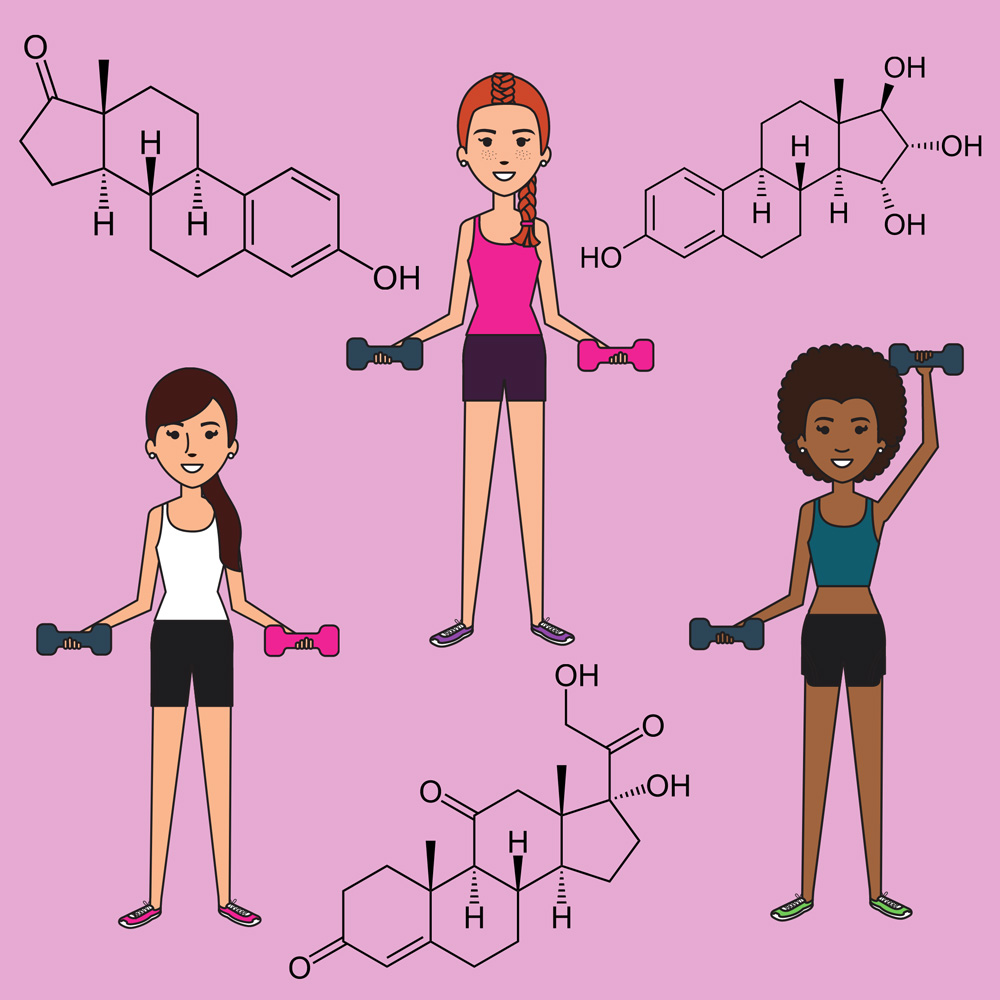Ladies! Many of you know an exercise program with weight training can help you lose fat, build shape, and keep you trim and toned. What you may not know is how your cycle’s hormones affect your strength training and workout routine. Let’s take a quick crash course!
There are three main hormones involved in your menstrual cycle:
Estrogen: For females, estrogen is the primary sex hormone. Estrogen is dominant in the first half of the menstrual cycle, and is responsible for building up your uterine lining to provide a nice, cozy space for a potential fertilized egg to grow. Estrogen is also responsible for contributing to strong and healthy bones, a full and voluminous head of hair, and your lovely female curves. It also helps keep your brain firing on all cylinders, and your heart in tip-top shape. When I said primary, I mean primary!
Progesterone: This hormone is produced by the corpus luteum, a group of cells formed after ovulation. Progesterone’s main job is to thicken the lining of your uterus, and maintain a healthy pregnancy if one occurs. However, progesterone also does amazing things like reduce anxiety, and combat insomnia. It is also great for helping our bodies use fat for energy, build and maintain healthy bones, and aid in healthy thyroid function. It even helps protect from breast and uterine cancer. Yeah, progesterone is pretty great!
Testosterone: This natural anabolic sex hormone is secreted by the ovaries and the adrenal glands. Testosterone levels will increase right before ovulation. While testosterone is often thought of as a male hormone, females need it too! Without it, we would find ourselves with weak bones, a lack of motivation and sex drive, fatigue, and an overall lack of confidence making us feel downright crummy.
When it comes to female hormones and weight training, these are the ones you need to know about. Lets learn a little about how these hormones correlate with the 3 stages of the menstrual cycle…
There are 3 main phases of your menstrual cycle:
*Please note this chart is indicative of a stereo-typical 28-day menstrual cycle. However, a “normal” cycle can look many different ways, lasting anywhere from 21-35 days.
Follicular Phase: The follicular phase, which is typically days 1-14, will start with your period. Shedding of the uterine lining will typically last anywhere around 3-7 days. The main purpose for the increase in estrogen during this phase is to mature an egg, or follicle, in preparation of ovulation.
Ovulation: Typically occurs on days 14-15, but not always. This is when the mature egg is released from the ovary, and there is a brief rise in testosterone.
Luteal Phase: Days 15-28. The corpus luteum (a group of cells that develop after ovulation) will begin making progesterone during this phase. This is also when a fertilized egg will implant itself.
How to adapt your weight training routine to your cycle for maximum results:
With the right approach, you can utilize changes in your hormone levels during your menstrual cycle to your weight training advantage!
Take advantage of your Estrogen
Estrogen reduces fatigue and muscle damage, meaning you can tolerate more intense workouts with minimal negative effects. Estrogen also helps in blunting pain, while supporting your ability to develop machine-like tolerance causing an increase in time-to-exhaustion. Overall, the increase in estrogen levels during your follicular and ovulatory phases result in increased and optimal stamina levels, allowing you to participate in longer and more intense workouts. This would be an ideal time for you to push yourself to the limit, increase your weights, or try a new challenging routine.
Key points to remember about Estrogen:
- Heavy weight training sessions are best during the follicular phase when estrogen is high.
- You will experience lower levels of muscle damage and fatigue when estrogen is high, so you will be able to train harder and recover faster!
- Your overall exercise performance is optimal during mid-to-late follicular phase and ovulation when estrogen is at it’s highest.
Take advantage of your Testosterone
Testosterone plays a huge role when it comes to strength training! Optimal levels of testosterone contribute to more energy and endurance, better strength and lean muscle mass, lower levels of body fat, more confidence, and fewer mood swings during your period.
However, up to 90% of women over the age of 45 have low testosterone levels! (Normal levels range from 25-70 ng.dL, 15 times lower than men) This deficiency in testosterone can be a major factor in patients I see experiencing low libido, stubborn weight gain, fatigue, and even depression and anxiety! While I treat low testosterone levels with many different approaches, I almost always encourage patients to add strength training to their routine. This recommendation is supported by numerous studies showing strength training effectively elevates testosterone levels.
Key points to remember about Testosterone:
- Testosterone promotes increases in lean muscle mass, while at the same time reducing body fat.
- The best time to do a hard strength-training workout, or go for a personal record, is during the latter half of the follicular phase through ovulation. The combination of estrogen and testosterone is perfect for peak athletic performance.
Take advantage of your Progesterone
Progesterone produced in the luteal phase will have two main functions affecting strength training. First, it will elevate your overall body temperature leaving you feeling hot, tired, and uncomfortable during tough workouts. Second, progesterone has a catabolic effect that increases muscle damage and can lead to an increase in fatigue while reducing athletic performance. Because your body is more focused on burning more fat and damaging muscle tissue during the luteal phase, participating in some more cardiovascular workouts, such as running, walking, or biking, will work nicely.
Key points to remember about Progesterone:
- Progesterone can elevate muscle damage and make recovery from weight training more difficult.
- Progesterone elevates body temperature, making workouts more uncomfortable.
In summary:
Female hormones such as Estrogen, Progesterone and Testosterone can go hand in hand with strength training! Adapting the way you train according to your menstrual cycle and hormone fluctuations can help you achieve your health and fitness goals faster and more efficiently. Work smarter, not harder!
Here is a great strength-training workout (a 35-minute dumbbell workout) from one of my favorite YouTube channels, Fitness Blender:


